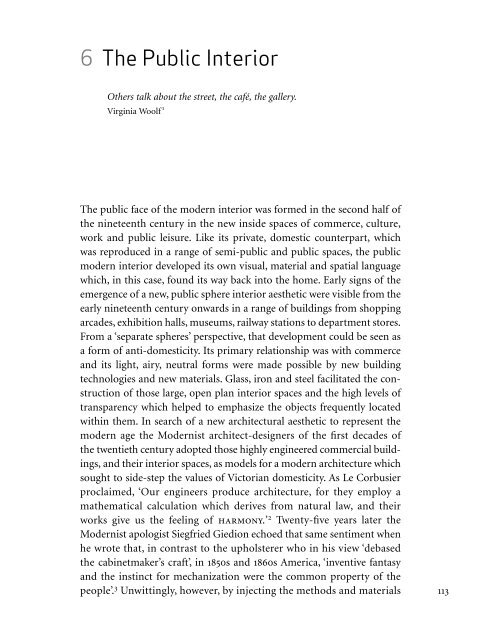Create successful ePaper yourself
Turn your PDF publications into a flip-book with our unique Google optimized e-Paper software.
6 <strong>The</strong> Public <strong>Interior</strong><br />
Others talk about the street, the café, the gallery.<br />
Virginia Woolf 1<br />
<strong>The</strong> public face of the modern interior was formed in the second half of<br />
the nineteenth century in the new inside spaces of commerce, culture,<br />
work and public leisure. Like its private, domestic counterpart, which<br />
was reproduced in a range of semi-public and public spaces, the public<br />
modern interior developed its own visual, material and spatial language<br />
which, in this case, found its way back into the home. Early signs of the<br />
emergence of a new, public sphere interior aesthetic were visible from the<br />
early nineteenth century onwards in a range of buildings from shopping<br />
arcades, exhibition halls, museums, railway stations to department stores.<br />
From a ‘separate spheres’ perspective, that development could be seen as<br />
a form of anti-domesticity. Its primary relationship was with commerce<br />
and its light, airy, neutral forms were made possible by new building<br />
technologies and new materials. Glass, iron and steel facilitated the construction<br />
of those large, open plan interior spaces and the high levels of<br />
transparency which helped to emphasize the objects frequently located<br />
within them. In search of a new architectural aesthetic to represent the<br />
modern age the <strong>Modern</strong>ist architect-designers of the first decades of<br />
the twentieth century adopted those highly engineered commercial build -<br />
ings, and their interior spaces, as models for a modern architecture which<br />
sought to side-step the values of Victorian domesticity. As Le Corbusier<br />
proclaimed, ‘Our engineers produce architecture, for they employ a<br />
mathematical calculation which derives from natural law, and their<br />
works give us the feeling of harmony.’ 2 Twenty-five years later the<br />
<strong>Modern</strong>ist apologist Siegfried Giedion echoed that same sentiment when<br />
he wrote that, in contrast to the upholsterer who in his view ‘debased<br />
the cabinetmaker’s craft’, in 1850s and 1860s America, ‘inventive fantasy<br />
and the instinct for mechanization were the common property of the<br />
people’. 3 Unwittingly, however, by injecting the methods and materials 113



